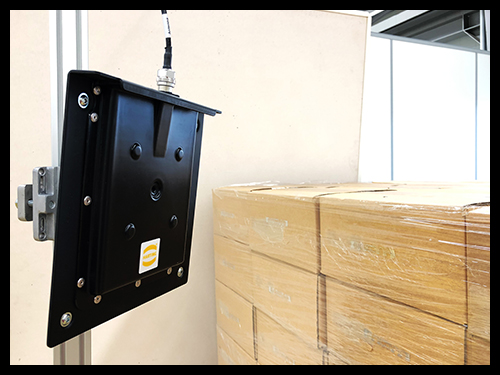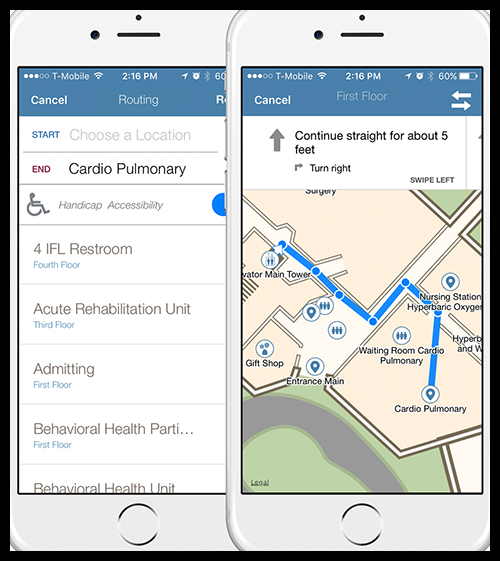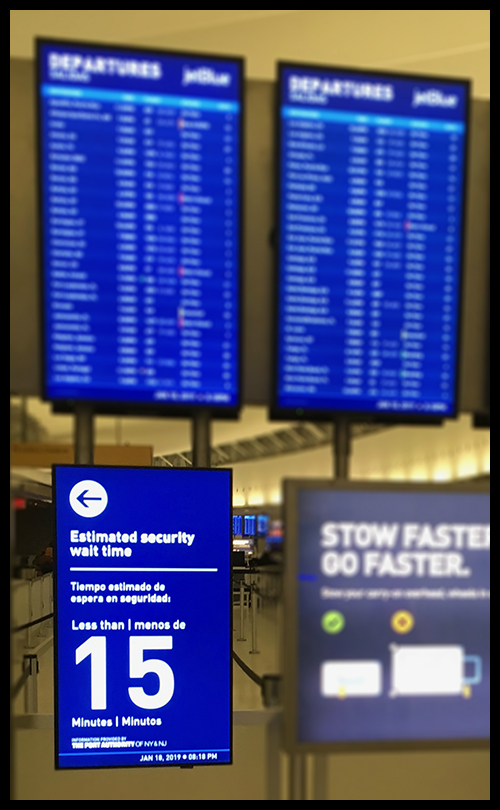Presented here are news announcements made during the past week by the following organizations:
HARTING Technology Group;
Smartrac Technology Group, Sasken Technologies;
HID Global, Phunware;
Current Health;
DigiCert, Utimaco, Microsoft Research;
UrsaLeo, Google; and
Port Authority.
HARTING Releases Gate System Featuring CE-Compliant Control Cabinet, RFID Reader
HARTING Technology Group has introduced a new system to automate the flow of goods with UHF RFID technology. The GateToGo is a mobile data entry portal (gate) that can be set up quickly, the company reports, and can be used to run proof-of-concepts for logistics applications without programming effort.

Using HARTING’s MICA, together with its GS1 ALE 1.1-based middleware system, the collected pallet and object data can be filtered and compressed directly at the gate. From there, the data is transmitted via network cables, Wi-Fi or directly via LTE to an enterprise resource planning (ERP) system. When using LTE, there is no need for complex integration into a local IT infrastructure, according to the company.
With a worldwide partner network, HARTING provides solutions that extend into the cloud. The GateToGo system includes a robust CE-compliant control cabinet, an RFID reader, the MICA and starter software.
Smartrac, Sasken Announce Strategic Partnership for IoT Solutions
Smartrac Technology Group, a provider of RFID products and Internet of Things (IoT) solutions, and Sasken Technologies, product engineering and digital transformation services provider, have announced a strategic technology partnership for IoT solutions. The two companies will combine their respective capabilities to create IoT solutions intended to drive value in operations, supply chain and customer engagement, focusing on brand owners, retailers, and the industrial and logistics sectors.
“The combination of Smartrac’s industry-leading RFID transponder technology, our innovative Smart Cosmos solutions platform and Sasken’s strong services delivery expertise brings unequaled new capabilities to the global market for companies looking to optimize supply chains, enhance customer engagement, and drive efficiencies across their value ecosystem,” said Dinesh Dhamija, Smartrac’s chief technology officer and a member of the company’s management board, in a prepared statement. “We look forward to rapidly delivering innovation in the IoT sector with this new level of performance and operational excellence.”
“Through our collaboration we will make our customers’ products and assets smarter, enabling enhanced and improved performance across all aspects of our customers’ businesses, leveraging the latest innovations in IoT technology,” said Raman Sapra, Sasken’s executive VP and general manager for digital, in the prepared statement. “We will use Smartrac’s solutions platform Smart Cosmos and IoT capabilities along with our Digital services capabilities in Cloud, IoT, Mobile Apps and Analytics to deliver innovative industry-specific applications that enable our customers to realize the value of digital.”
HID Global, Phunware Collaborate to Improve Wayfinding for Hospital Patients and Visitors
HID Global, a provider of trusted-identity solutions, and Phunware, an integrated enterprise cloud platform for mobile technologies that provides products, solutions, data and services for brands worldwide, have announced a collaboration to improve the experience for hospital patients and visitors, to help them find their way within medical facilities via a wayfinding app on their mobile phones. Wayfinding is indoor navigation to guide a person step-by-step on the way to a desired destination.
“The combination of Phunware’s market-leading wayfinding and mobile engagement capabilities with innovative HID Location Services will ultimately revolutionize wayfinding within healthcare institutions,” said Alan S. Knitowski, Phunware’s co-founder and CEO, in a prepared statement. “It’s easy for visitors and patients to get lost in hospitals, and every time they do it puts appointment times and patient satisfaction at risk. With our location-aware app on a mobile device, we equip the visitor to get instant, turn-by-turn navigation that creates a better experience than that which is currently available on the market.”

According to Phunware and HID, the two companies hope to address the need of health-care institutions to deploy standardized technology to provide a better wayfinding and visitor-engagement experience inside hospitals, across campuses and in parking lots.
“Wayfinding is one more application that we are integrating into HID’s unified healthcare IoT solution to make it easier for healthcare systems to manage a growing demand for automated and streamlined experiences,” said Rom Eizenberg, the VP of sales, at Bluvision (part of HID Global), in the prepared statement. “With HID technologies, we have changed the location-aware landscape, delivering location as a service. Now, healthcare organizations can easily lay out the foundation for IoT applications, such as wayfinding.”
HID’s health-care IoT solution-enablement platform is designed to simplify the delivery of real-time location of clinicians, patients and devices, the company reports. The platform is enabled by Bluvision. Phunware’s Multiscreen-as-a-Service platform provides enterprise-level mobile wayfinding, engagement and data for vertical markets, including retail, residential, hospitality, media and entertainment.
Current Health Receives FDA Clearance for Its Remote Patient-Monitoring Solution
Current Health, the manufacturer of an artificial intelligence (AI)-powered wearable, has announced that it has received Class II clearance from the U.S. Food and Drug Administration (FDA) for hospital care. Current Health’s offering is a wireless device that continuously and automatically monitors patients to help better determine health trajectory, allowing clinicians to intervene earlier.
Faced with an aging population and strained health-care systems worldwide, U.S. and U.K. health-care providers are deploying the Current Health system to change their patient-delivery models from reactive to proactive care, in order to produce better patient outcomes. Current’s approach is intended to help health organizations reduce unnecessary hospital readmissions for patients whose conditions deteriorate after treatment—an expensive and cumbersome clinical burden that costs U.S. hospitals more than $40 billion annually.
Mount Sinai Brooklyn is working with Current Health to detect patient deterioration earlier and improve health-care outcomes. “The Mount Sinai Health System works with innovative and leading-edge companies like Current to support our commitment to providing world-class patient care,” said Dr. Scott Lorin, the president of Mount Sinai Brooklyn, in a prepared statement. “Current’s continuous and proactive monitoring platform has the potential to alert us to patient deterioration faster and give our team data insights they can act on earlier.”
Built using a real-time physiological data set, the solution’s proprietary algorithms continuously analyze data, along with relevant contextual patient information, to offer actionable and proactive insights into a wearer’s health. It integrates with third-party devices to capture additional metrics, building patient-specific digital therapeutics and recommendations.
Current Health’s solution is actively in use with several U.K. health-care providers in a post-acute setting, including the Dartford and Gravesham NHS Trust, which serves a local population of 500,000 people. The trust’s At Home team uses the technology to remotely monitor patients following discharge. As a result, the company reports, clinicians and personnel have been able to reprioritize home visits based on criticality, resulting in a 22 percent reduction in home visits and fewer hospital readmissions and emergency department visits, which has freed up skilled nursing time and helped patients feel safe and secure.
“At Current, we’re a small team of individuals committed to changing the world through proactive healthcare,” said Christopher McCann, Current Health’s CEO, in the prepared statement. “Our team worked hard to get here, and it’s just the first step toward monitoring the health of every human being to identify sickness earlier with the goal of saving lives. Today, we’re in the hospital, tomorrow the home, and in the near future, we’ll be everywhere. We are just getting started.”
DigiCert, Utimaco, Microsoft Research Collaborate to Secure IoT from Quantum-Computing Threats
a provider of TLS/SSL, IoT and PKI solutions; Utimaco GmbH, a provider of hardware security modules; and Microsoft Research, a quantum-safe cryptography company, have announced a test implementation of the Picnic algorithm, with digital certificates used to encrypt, authenticate and provide integrity for connected devices in the Internet of Things (IoT). This proof of concept provides a path toward a full solution, currently in development, that will protect IoT devices from future threats quantum computing could pose to today’s widely used cryptographic algorithms.
Currently, most IoT devices use RSA and ECC to protect confidentiality, integrity and authenticity for device identities and communication, the partners explain. Experts from the security community, including Dr. Brian LaMacchia from Microsoft Research, predict that large-scale quantum computers capable of breaking RSA and ECC public-key cryptography will exist within the next 10 to 15 years. Devices such as connected cars, smart homes, connected cities, connected medical devices and other critical infrastructures will either live longer than this or take longer to update, they add.
“DigiCert, Microsoft Research and Utimaco are collaborating today to solve tomorrow’s problem of defending connected devices and their networks against the new security threats that the implementation of quantum computers will unleash,” said Avesta Hojjati, the head of DigiCert Labs, the company’s R&D unit, in a prepared statement. “Together, we are leading the market with development of hybrid certificates that inject quantum-resistant algorithms alongside RSA and ECC to ensure long-term protection.”
The certificates are issued by DigiCert using the Picnic quantum-safe digital signature algorithm developed by Microsoft Research. To implement this algorithm and issue certificates, DigiCert has used an Utimaco hardware security module. The full solution, in development, would provide quantum-safe digital certificate issuance and secure key management, helping companies future-proof their IoT deployments. “The cooperation between DigiCert, Microsoft Research and Utimaco will help organizations implement secure and future-proof IoT products that are protected against the potential security threats of quantum computing,” said Dan Timpson, DigiCert’s CTO, in the prepared statement.
Enterprises will be able to cost-effectively deploy these solutions at any scale, the companies report. Further, the partners will provide solutions and tools to manufacturers of IoT devices to help them remain prepared for quantum threats and keep sensitive information and high-value assets safe. “DigiCert, Utimaco and Microsoft’s successful test implementation provides a fundamental building block for the implementation of quantum-safe solutions,” said Dr. Thorsten Grötker, Utimaco’s CTO, in the prepared statement. “Using these solutions, IoT manufacturers and other large organizations can innovate and develop products that are well prepared against coming quantum threats.”
“The work that Microsoft Research is doing with DigiCert and Utimaco is important to develop quantum-secure cryptographic algorithms, protocols and solutions today so that in the near future enterprises will be able to transition to and deploy quantum-safe cryptography,” said Brian LaMacchia, the head of Microsoft Research’s Security and Cryptography Group, in the prepared statement. “Working to ensure that their solutions are cryptographically agile will help companies avoid expensive and unscalable security practices to protect their IoT devices against future security threats.”
UrsaLeo Accepted Into Google SaaS Partner Program
UrsaLeo, an Internet of Things (IoT) platform-as-a-service technology company that connects OEMs with the cloud, has announced that it has been accepted into Google‘s SaaS Partner Program. The company’s IoT platform allows users to store, analyze and act on data collected from all types of industrial equipment.
As a Google Cloud and SaaS partner, the company has configured cloud-enabled hardware that collects data and delivers dashboards, sensor diagnostics and data-storage management. Google Cloud SaaS Partners create innovative business solutions running on Google Cloud Platform and deliver their managed solutions via a subscription offering from Google Cloud.
“The power of IoT and Cloud technology is within grasp for manufacturers of all types for the collection and analysis of big data,” said John Burton, UrsaLeo’s CEO, in a prepared statement. “We are proud to be a Google Cloud and SaaS partner and participate in a program that ensures product reliability, offers immersive training programs for our entire team, and is opening doors to new clients and other industry players.”
Port Authority Airports Track Security and Taxi Wait Times Online
Passengers at the John F. Kennedy International (JFK), Newark Liberty International (EWR), LaGuardia (LGA) and New York Stewart International (SWF) airports can now access up-to-date Transportation Security Administration (TSA) and taxi wait times on the Port Authority’s respective airport websites.
The real-time tracking information is part of the Port Authority’s efforts to deliver an enhanced customer experience for passengers using its airports. TSA wait times at LaGuardia’s Terminals C and D went live on the LGA website this month, becoming the latest terminals to be activated. Wait time information also is available inside terminals.

Launched in late November, the tracking system allowed passengers in most airport terminals to remotely check on TSA checkpoint wait times during the recent government shutdown. All 14 terminals across the agency’s four airports now have the capability, with the exception of United Airline’s Terminal C at Newark Liberty. United hopes to have its system go live later this year.
The Port Authority, in coordination with the TSA and other agency partners, has installed BlipTrack, a real-time measurement tool to track and display wait times at TSA checkpoint screening areas and taxi stands. The goal is to provide this information so travelers know what to expect and to enable them to plan their travels better and on a more informed basis, and to enable airports to develop strategies and to target resources to reduce wait times.
“We are focused on enhancing the customer experience at our airports by providing this critical information,” said the Port Authority’s chairman, Kevin O’Toole, in a prepared statement. “The installation of BlipTrack allows us to provide customers with the real-time information they need to plan their travels. Even more importantly, it provides us data to focus on how to reduce wait times going forward.”
“In today’s increasingly interconnected world, the passenger’s journey begins before they leave for the airport,” said Port Authority executive director, Rick Cotton, in the prepared statement. “With this real-time data posted on each of the airport’s websites, wait times are now readily available to help reduce passenger stress and enable travelers to plan based on the wait times they will encounter. At the same time, as we saw during the recent government shutdown, the information makes it easier for airport staff to monitor checkpoint wait times and call for additional resources to congested areas.”
With respect to taxi lines, the technology helps travelers make informed decisions regarding ground transportation. It also enables the airport to identify taxi shortages and bottlenecks, thereby enabling airport staff to request additional taxis when needed.

